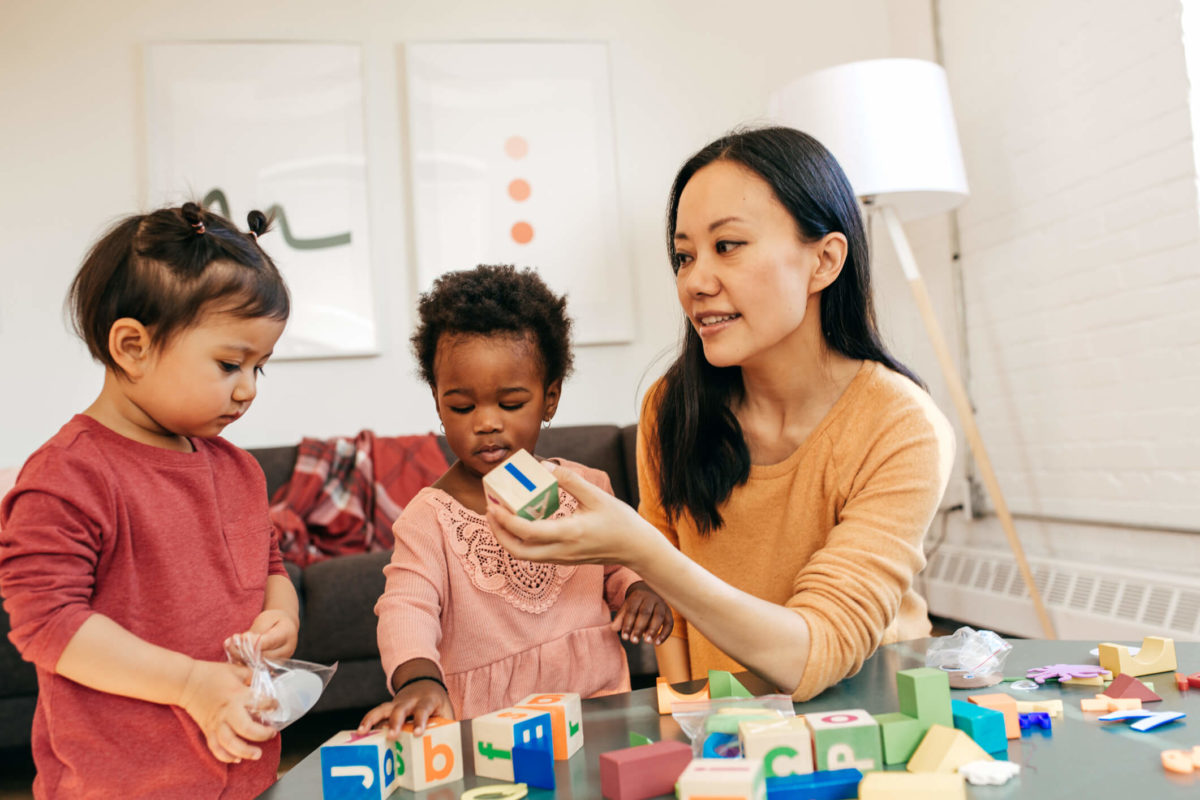
1. Peek-a-boo!
It’s an all-time classic for a reason — babies and toddlers just love it! Initially, use a transparent scarf or piece of fabric and briefly trail it over your face, so your baby can see your face and then you momentarily disappear. As your face is covered, start saying “Peek-aaa… ” then pop out and say “boo!” Babies find this hilarious and will give you lots of smiles.
You can then try trailing the fabric over your baby’s face using the same routine, and encourage your baby to pull it off. Once he gets the hang of it, you can make the game more interactive by leaving a long pause after saying “Peek-aaaaaaaa… ” to allow time for your baby to make an excited movement or noise (after which you say “boo”). The baby’s sounds should eventually form a “boo.” This type of game is known as an anticipation game — you are anticipating that your baby will say a sound or attempt a particular word. By providing an entertaining reaction when your child communicates with you, you encourage his attempts at talking, which you will notice grow more frequent.
This is a good game for infants as young as eight weeks. Make sure your baby is lying down so she doesn’t have to think about head support or balance. Move close to your baby and make eye contact. Say something like “Hello, my gorgeous girl,” in a sing-song voice. Wait. (You may need to wait as long as 10 seconds.) Smile and look at your child with anticipation. Once she makes a noise, say, “Ah. Now you’re talking, good job!” Wait again. When they respond this time say, “What a nice story you’re telling me. Is there any more?”
Keep the chat going for as long as possible, with as many communicative exchanges as possible. This is called the art of taking turns, and as an early form of conversation, it’s a great one for your baby to master. Once your baby realizes that they have to “talk” to take a turn, you will hear many more attempts at words.
Find some noise-making objects that you can use to encourage babbling and put them in a bag. Theatrically pull them out one by one and make a big deal of the sounds they make.
Here are some ideas:
- “b, b, b, b, b” – Banging an inflated balloon against your hand.
- “d, d, d, d, d” – Banging a drum.
- “sh, sh, sh, sh, sh” – Put your fingers to your lips and make the “shhh” sound. This will be too difficult for a baby to mimic in the beginning, but keep doing it and your child will soon copy the action and then later develop the sound.
- “ch, ch, ch, ch, ch” – Make the train noise. At first this will be tricky for your child to copy, but he will love hearing it and will eventually attempt it himself. Keep in mind that all sounds appear in a specific developmental order and “sh” and “ch” come at later stages.
- “mmmmm” – Play with a yummy piece of plastic food or the wrapper from a type of food you know your child loves to eat.
-
It’s a good idea to have a mirror nearby so children can watch themselves make the noises — they find this endlessly fascinating and it helps them stay focused for longer. The more children babble, the more practice they have at forming the proper sounds to develop language skills.
To help your child with her language skills, sing a familiar song and then wait for her to react when you pause for the key word, for example, “If you see a crocodile, don’t forget to… scream… Ahh!
Action songs or songs with hand gestures are the best. Remember to sing slowly and encourage participation by looking expectantly at your child and leaving a gap for her to join in. Stress and repeat words and praise their efforts when they join in. You’ll find that they often start by filling in the last word of a song lyric, because this is usually where we naturally stress the word. With time and repetition, they will eventually fill in more and more words until they are singing the whole song for you.
This simple gesture is so important, since the rate of speech acquisition can actually be related to the onset of pointing. Psychologist LuigiaCamaioni of the University of Rome La Sapienza found that the earlier babies begin to point, the more words they know at 20 months of age! The correlation may be due to the higher level of social awareness of a child who has already acquired the ability to point. When you use your finger to point something out to someone, you have to be aware of whether the other person is looking, and you have to understand pointing as a means of communication. You also need to be able to comprehend the concept of cause and effect — if I point, I will get that object.
Help your child point to each picture in his favorite book and when it’s time for snacks, give your child a choice by holding a banana in one hand and a cracker in the other and encouraging him to point to the one he wants. This also works with toys.
TO BE CONTINUED…
Nicola Lathey
Speech and Language Therapist
The Owl Centre
The views expressed in the blog do not necessarily represent the views of ASLTIP. Publication does not imply endorsement. –

